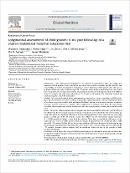| dc.contributor.author | Prudence, Atukunda | |
| dc.contributor.author | Moses, Ngari | |
| dc.contributor.author | Xi, Chen | |
| dc.contributor.author | Ane, C. Westerberg | |
| dc.contributor.author | Per, O. Iversen | |
| dc.contributor.author | Grace, Muhoozi | |
| dc.date.accessioned | 2024-02-14T08:22:23Z | |
| dc.date.available | 2024-02-14T08:22:23Z | |
| dc.date.issued | 2021-08 | |
| dc.identifier.citation | Atukunda, P., Ngari, M., Chen, X., Westerberg, A. C., Iversen, P. O., & Muhoozi, G. (2021). Longitudinal assessments of child growth: A six-year follow-up of a cluster-randomized maternal education trial. Clinical Nutrition, 40(9), 5106-5113. | en_US |
| dc.identifier.uri | https://hdl.handle.net/20.500.12504/1609 | |
| dc.description.abstract | Background & aims:
Child growth impairments are rampant in sub-Saharan Africa. To combat this
important health problem, long-term follow-up studies are needed to examine possible benefits and
sustainability of various interventions designed to correct inadequate child growth. Our aim was to
perform a follow-up study of children aged 60e72 months whose mothers participated in a two-armed
cluster-randomized education intervention trial lasting 6 months in rural Uganda when their children
were 6e8 months old with data collection at 20e24 and at 36 months. The education focused on
nutrition, hygiene, and child stimulation.
Methods:
We measured growth using anthropometry converted to z-scores according to WHO guide-
lines. We also included assessments of body composition using bioimpedance. We used multilevel mixed
effect linear regression models with maximum likelihood method, unstructured variance-covariance
structure, and the cluster as a random effect component to compare data from the intervention
(receiving the education and routine health care) with the control group (receiving only routine health
care).
Results:
Of the 511 children included in the original trial, data from 166/263 (63%) and 141/248 (57%) of
the children in the intervention and control group, respectively, were available for the current follow-up
study. We found no significant differences in any anthropometrical z-score between the two study
groups at child age of 60e72 months, except that children in the intervention group had lower
(P ¼ 0.006) weight-for-height z-score than the controls. There were no significant differences in the
trajectories of z-scores or height growth velocity (cm/year) from baseline (start of original trial) to child
age of 60e72 months. Neither did we detect any significant difference between the intervention and
control group regarding body composition (fat mass, fat free mass, and total body water) at child age 60
e72 months. Separate gender analyses had no significant impact on any of the growth or body
composition findings.
Conclusion:
In this long-term study of children participating in a randomized maternal education trial,
we found no significant impact of the intervention on anthropometrical z-scores, height growth velocity
or body composition. | en_US |
| dc.language.iso | en | en_US |
| dc.publisher | Elsevier | en_US |
| dc.subject | Body composition | en_US |
| dc.subject | Growth impairment | en_US |
| dc.subject | Growth velocity | en_US |
| dc.subject | Maternal education | en_US |
| dc.subject | Stunting | en_US |
| dc.subject | Sub-Saharan Africa | en_US |
| dc.title | Longitudinal assessments of child growth: a six-year follow-up of a cluster-randomized maternal education trial | en_US |
| dc.type | Article | en_US |

